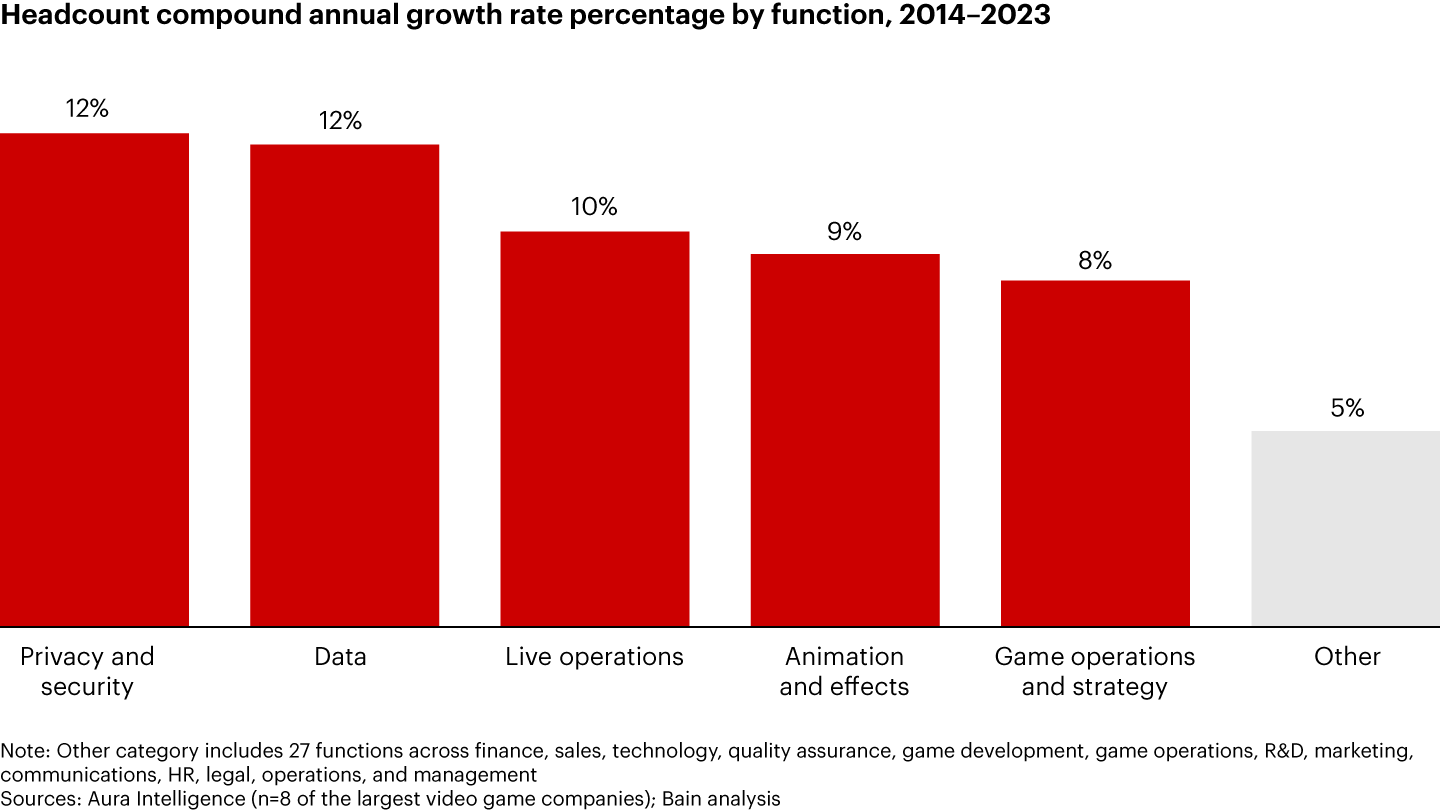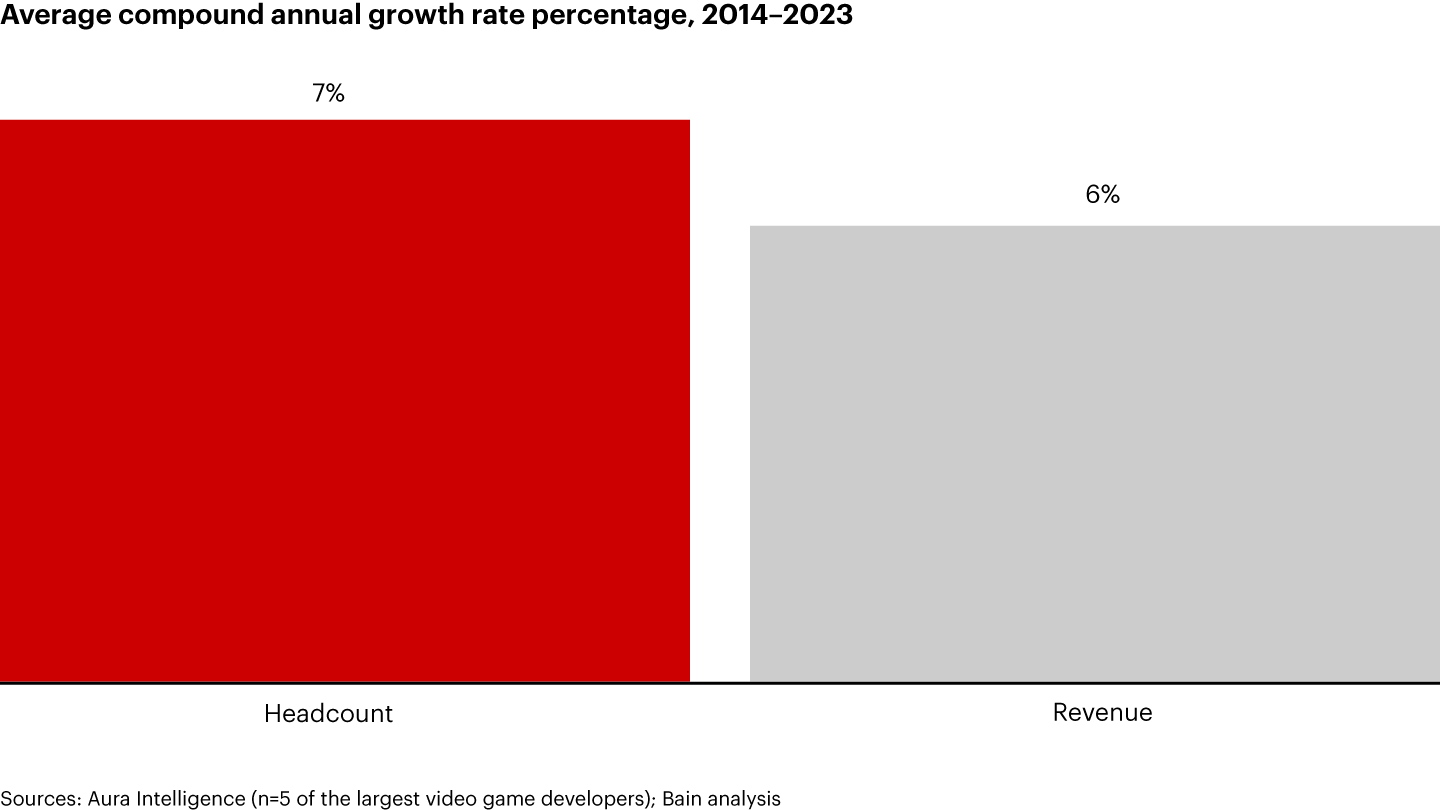Gaming Report
 }
}
概要
- Video game companies are getting bigger and more complex as they try to meet evolving consumer demand.
- The largest companies expanded their operational footprint by an average of 13 countries over the past decade—a 28% increase.
- The top game developers’ headcount growth slightly outpaced revenue growth during that period, implying minimal efficiency gains despite increased size.
- Leading companies are adapting their operating models by rethinking where and how work gets done and by investing in talent and technology.
This article is part of Bain's 2024 Gaming Report
As video game companies prepare for the industry’s next wave of growth, executives are finding that the operating model that got them to this point simply won’t work for the next chapter. That’s true for every video game company, whether it’s a small, single-game developer or a multibillion-dollar developer and publisher of AAA franchises.
Over the past decade, the video game industry has grown significantly. So, too, has its complexity. Gamers increasingly demand multiplayer, multiplatform experiences with more social features. Additionally, media types are converging as feature film and TV series adaptations of video games continue to draw significant audiences.
To meet evolving consumer demand, video game companies have become far larger and more complex. Eight of the top gaming companies employ people in 28% more countries than they did a decade ago, an average increase of 13 countries each. That’s according to Bain analysis of Aura Intelligence data on 12 studios operating in about 100 countries.
These companies’ mix of capabilities is also changing. The five fastest-growing functions—privacy and security, data analytics, live operations, animation and effects, and game operations and strategy—have increased headcount at around two times the average rate of all other business functions over the past decade, according to our analysis (see Figure 1).


The industry has reached a critical juncture. The explosive growth during the Covid-19 pandemic has subsided, leading many companies to manage costs by reducing headcount. However, we anticipate that the video game market will return to robust growth over the coming years. That means video game companies will have to adapt to the industry’s increased complexity, manage growth when it comes, and do it all with more constrained resources. They have no choice but to revamp their operating models—and quickly.
The situation is akin to the evolution of the traditional film and TV industry over the past two decades, when studios shifted from merging with each other to joining broader entertainment conglomerates. These new companies had to rethink their operating models to leverage intellectual property across a range of media and gain efficiencies from formerly independent studios.
Where’s the efficiency?
An effective operating model bridges the gap between strategy and execution. It’s the organizational structure, processes, governance, technology, culture, and ways of working that enable a company to deliver on its goals.
Many video game companies are struggling to adapt their operating model and take advantage of scale benefits as their organization grows. The average workforce size of the top video game developers we analyzed has risen 7% annually over the past decade, but their revenue has only grown 6% each year, implying minimal efficiency gains despite increased size (see Figure 2).


While each company’s dynamics are unique, in our work with video game companies worldwide, we consistently hear about certain common challenges:
- How can they take advantage of greater scale while also maintaining close connections with their players (e.g., building AAA games with more than 100 million players over multiple years while efficiently incorporating individual player feedback)?
- How do they continue to attract the best creative talent now that they’re larger and more complex (e.g., they’re no longer the “cool start-up”)?
- Which capabilities can be centralized within or across studios, and which would benefit from decentralization (e.g., standardizing developer tools vs. allowing each game team and studio to use their own)?
- As the number of products grows, how do companies rethink work processes to deliver the best experiences for their players (e.g., rethinking DevOps for high-production, live-service games that require a constant stream of efficiently produced new content long after the game’s initial launch)?
- Which capabilities and processes should they prioritize for innovation and investment (e.g., where to deploy AI tools vs. where to keep the status quo)?
- Where should they develop capabilities in-house vs. outsource (e.g., hiring external vendors for quality assurance and testing vs. building those functions internally)?
Adapting the operating model
It may seem daunting, but the trajectories of some of the most successful companies across industries over the past few decades have shown that it’s possible to scale up a business while maintaining an entrepreneurial mindset and staying nimble.
Leading companies first ensure that the business’s overall ambition and strategic direction are clear. They understand that they’re bound to fail if they pursue point solutions that don’t link to the company’s broader strategy.
With a clearly defined and communicated strategy in place, companies are well-positioned to adapt their operating model. Here are several principles that the most effective gaming companies are keeping top of mind as they try to provide the best experience for players while balancing their bottom line and growth.
Accept that it’s a continuous process. As games evolve from a single release to continuous live service, so, too, will operating models. Operating model redesign shouldn’t be a once-and-done overhaul every 5 to 10 years. While there will continue to be watershed moments that demand pressing the reset button, leading companies recognize it’s just as important to continuously refine their operating model to support rapidly evolving strategic imperatives (such as adding an entertainment arm or adjusting operational processes to take advantage of new technologies). Incremental, iterative improvement is less disruptive to the business, and it can deliver a lot of value.
Rethink where work is done across the organization. As they evolve, leading companies dynamically adjust where key activities are managed across the organization. This avoids duplication of work and ensures that the work is performed by the people and functions best positioned to deliver on it. For example, as a game company expands from one studio to multiple, it typically makes sense to continue housing creative game development within the studios since they’re on the front lines and have the most insight into what players want. By contrast, work that can be standardized across game teams and has strategic value may warrant being performed closer to the organizational center.
To efficiently deliver high-quality player experiences across its games, Riot Games created a “player platform” team charged with building standardized software and systems. These cover everything from account management and chat capabilities to the software development kits used by gaming teams companywide. Standardizing these elements across all the company’s games enabled the operating model to scale and allowed game development teams to focus on where they can deliver the greatest value: core gameplay.
Redesign processes to simplify work and provide clear accountability. Emerging leaders aren’t afraid to radically overhaul processes to simplify how work gets done and to clarify accountability. In a bid to remain innovative and attuned to players’ feedback as it scales up, Supercell recently announced a plan to structure new game teams as entirely separate entrepreneurial units. These teams won’t be subject to the typical fixed budget nor the project greenlight process. Instead, they will commit to key timelines, milestones, and resourcing plans to reach them. The idea is that independence combined with the pressure of transparency and accountability will foster creativity and results.
Invest in a model to attract, retain, and grow the best talent. To thrive during the next wave of growth, video game companies will need to recognize that they’re no longer competing solely against other video game companies for key talent but against the entire tech industry. Emerging leaders understand that they’ll need a more mature, comprehensive talent model that doesn’t just rely on employees’ passion for video games. They’ll need to invest in initiatives to increase employee engagement and enable them to do their jobs more effectively. This includes providing a sense of purpose; competitive compensation; work-life balance; learning opportunities; career support; and explicit environmental, social, and corporate governance commitments. (For more, read the Bain Brief “Beyond the Love of the Game: Talent in the Video Game Industry.”)
Empower that talent with technology and tools. Similar to most industries, defining and mobilizing an AI strategy has become an urgent boardroom topic for video game companies. Generative AI and related tools have significant implications for how video game companies revise their operating models, redefine how work gets done, and prioritize investments in organizational capabilities.
In our work with gaming and entertainment companies, those that embed generative AI within their existing operating models have largely seen progress stall and struggled to break out of experimentation mode (e.g., they have numerous disparate projects). Conversely, those that have elevated accountability and taken a more holistic approach to the opportunities that generative AI presents are starting to see early results and have a much clearer path to scaling.
The pressure is on
The video game industry faces a period filled with exciting opportunities but also turbulence. The pressure on video game companies to modernize their operating models is only increasing. However, if done effectively, it can lay the foundation for the next stage of growth.
The authors wish to thank Katie Chung, Nyla Brewster, and Brandon Rogers for their contributions to this article.